1. Project Overview
Introduction:
HOPE Network is an international platform committed to empowering youth and fostering collaboration on a global scale. The primary objective of this project was to design and develop a dynamic, user-centric website that facilitates the submission and sharing of youth-driven Best Practices, aligns with the United Nations Sustainable Development Goals (SDGs), and supports diverse stakeholders—including young leaders, organizations, and strategic partners.
This website serves as a comprehensive hub where visitors can access impactful initiatives, explore resources, engage with community members, and participate in collaborative efforts that drive sustainable development. The goal was to create an accessible, scalable, and responsive platform that showcases global impact, encourages youth involvement, and attracts partnerships.
Objectives:
- Develop an engaging and user-friendly platform to showcase youth-driven Best Practices.
- Align the website’s structure and content with the SDGs to amplify impact and global relevance.
- Support different user types (Young Leaders, Organizations, Country Representatives) with tailored pathways for participation and engagement.
- Implement a scalable and responsive design framework for accessibility and seamless user experience across devices.
- Create interactive features, such as filtering options, to enhance the user’s journey and make information more accessible.
2. Discovery Phase
Initial Client Meeting:
The discovery phase began with several collaborative sessions between the HOPE Network team and our design and development team. In these initial meetings, we focused on understanding the client’s goals, vision, and the primary audience for the platform. Together, we outlined the essential features, including:
- A user-friendly Best Practices Library with filtering options by country and SDG.
- Dedicated pages for Member Countries to highlight Country Representatives and showcase their initiatives.
- A comprehensive Resources section to provide FAQs, media libraries, and press releases.
- Interactive and visually appealing components, such as an interactive global map and dynamic image galleries.
Our team gathered requirements on functionalities, discussed brand guidelines, and identified the need for multilingual capabilities to increase global reach. This collaborative approach set the foundation for a detailed action plan.
Research & Competitor Analysis:
To build a platform that stands out, we conducted extensive research into existing NGO websites, focusing on those that align with global collaboration and youth empowerment missions. We analyzed their structure, user experience, and best practices, identifying key design elements and interactive features that could be beneficial for HOPE Network.
The research highlighted the importance of:
- A centralized resource library for sharing knowledge and engaging stakeholders.
- Interactive maps to represent global reach and membership visually.
- Filtering options for youth-driven projects, making it easier for users to access relevant information quickly.
By benchmarking these features, we tailored our approach to fit HOPE Network’s specific needs, ensuring the platform is intuitive and appealing for a diverse audience.
Sitemap & Action Plan:
Based on the insights gathered, we developed a detailed sitemap to structure the website. The sitemap was designed to create an intuitive navigation flow, making it easy for users to explore the platform and engage with various resources. Key sections include:
- About: Featuring the mission, vision, and alignment with SDGs.
- Member Countries: Highlighting Country Representatives and their initiatives.
- Best Practices Library: Showcasing youth-driven projects, filtered by SDGs and regions.
- News & Events: Providing updates on past and upcoming events, as well as recent news.
- Resources: Offering FAQs, press releases, image/video libraries, and statistics for a comprehensive user experience.
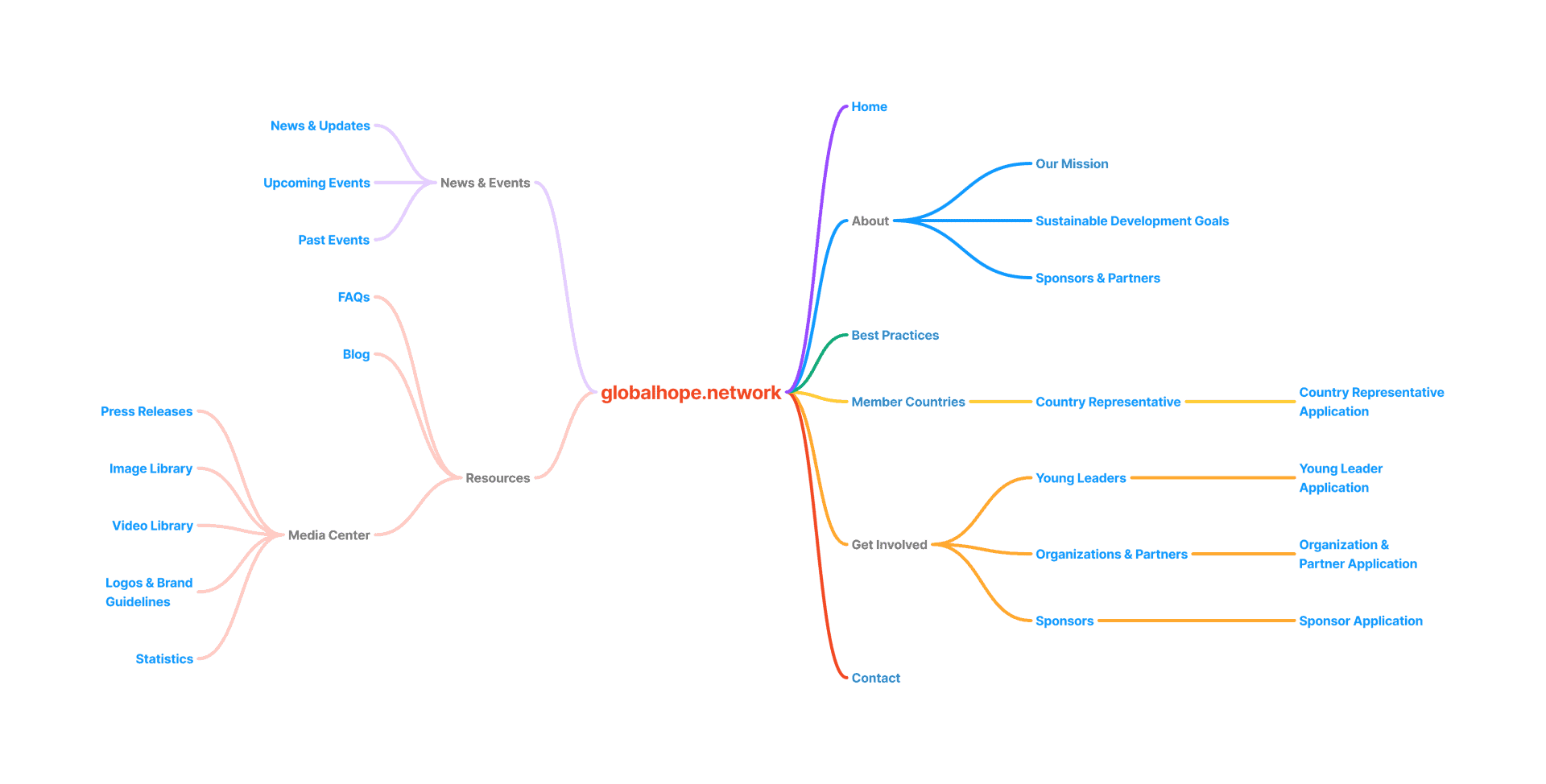
Website Sitemap: A comprehensive roadmap outlining the structure and navigation of the website, ensuring a seamless user journey and organized content flow.
The Action Plan was laid out in a phased approach to ensure smooth execution:
- Discovery: Gather client requirements and finalize the sitemap and structure.
- Wireframing: Develop interactive wireframes for each key section to define the visual and functional layout.
- Design (After Development): Apply visual styles using ACSS for consistency, followed by client feedback incorporation.
- Development: Build the site using ACSS and Frames, ensuring a scalable and maintainable framework.
- Testing: Perform quality assurance testing to optimize performance and ensure responsiveness.
- Deployment: Launch the website and provide CMS training and documentation for client support.
3. Wireframing
Wireframe Development:
The wireframing phase was crucial in translating the insights from the discovery phase into a functional blueprint for the website. Using Frames and Automatic.css (ACSS), we developed interactive wireframes that formed the skeleton of each page. These tools allowed us to quickly create a responsive and scalable design while maintaining a high level of accessibility and consistency across the site.
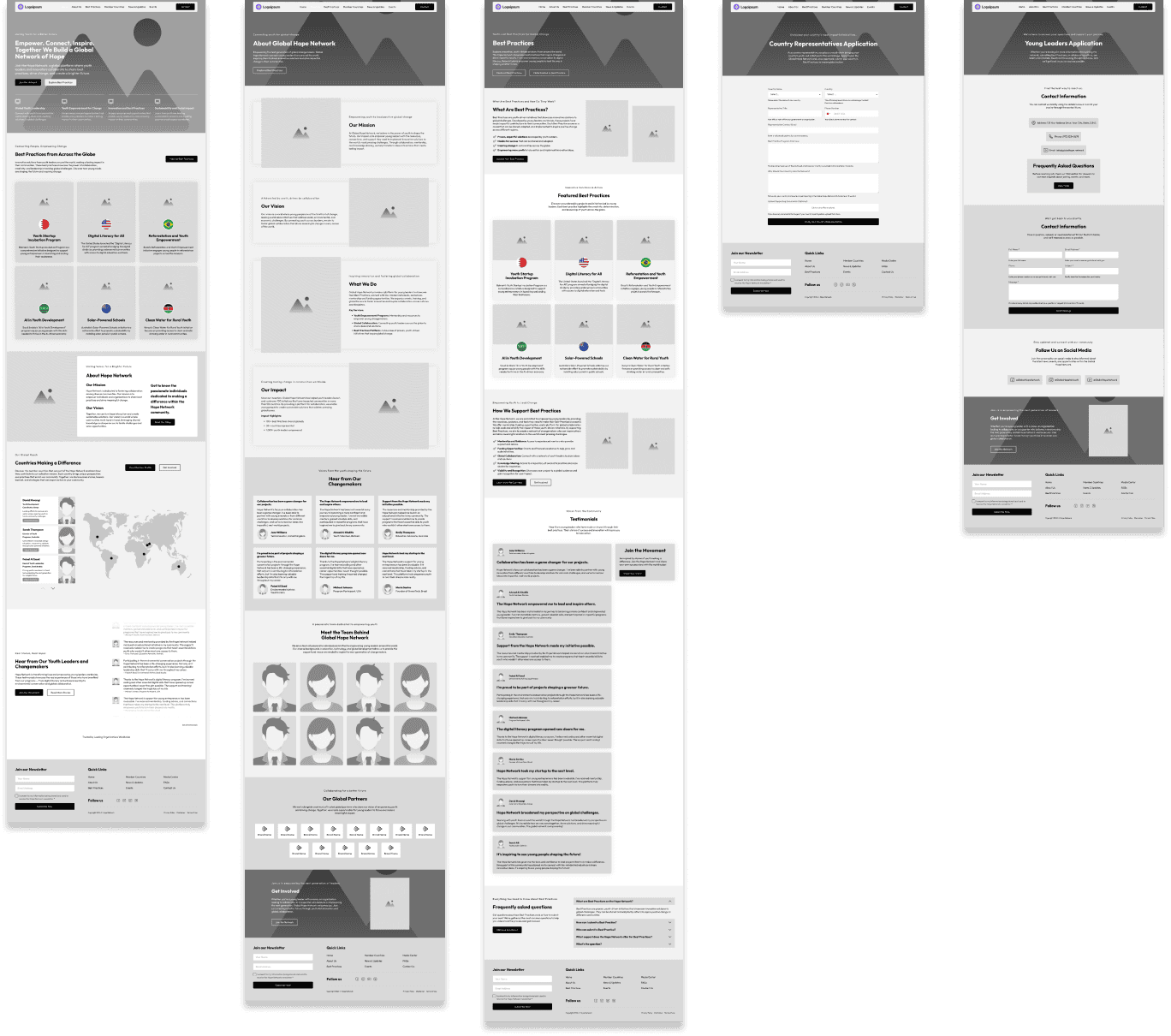
Bird’s Eye View of Main Pages Wireframes: An overview of the main page layouts, showcasing the strategic placement of key elements to optimize user engagement and enhance the site’s visual appeal.
Why Use Frames and ACSS?
- Effortless Design Consistency: ACSS provides simple classes and tokens, ensuring consistent typography, spacing, and colors throughout the site, reducing decision fatigue and speeding up the development process.
- Automatic Mobile Optimization: ACSS automates much of the work required to make the site look fantastic on mobile devices, saving time and ensuring a seamless, responsive experience for users.
- Maintainability & Scalability: With ACSS, the site is scalable and easy to maintain. Elements can be modified efficiently, ensuring the platform remains flexible as the client’s needs evolve.
- Quick Assembly with Frames: Frames allowed us to utilize pre-built components crafted by professionals, accelerating the development of layouts. By quickly building accessible, conversion-ready layouts, we streamlined the wireframing process while ensuring best practices.
The combination of these tools allowed us to focus on creating a visually cohesive and intuitive structure for each page, ensuring users have a consistent and engaging experience across devices.
Key Pages and Layouts:
We developed wireframes for the following key pages, ensuring they aligned with the sitemap and the project’s objectives:
- Home Page: Designed with a hero section, key CTAs, and sections that lead visitors to explore the Best Practices, News & Events, and Resources sections.
- Best Practices Library: A hub for showcasing global initiatives, featuring filters by region and SDGs for easy navigation.
- Member Countries: Featuring an interactive map and individual country profiles, emphasizing the network’s global reach.
- Resources Section: Structured to provide easy access to FAQs, media resources, and statistics, encouraging engagement.
Each wireframe focused on clarity and functionality, ensuring that users could access information intuitively while highlighting HOPE Network’s global and youth-driven initiatives.
Client Collaboration:
Throughout the wireframing phase, we maintained open communication with the client. We conducted regular review sessions to ensure the wireframes aligned with their vision and objectives. The client provided feedback on:
- Navigation Flow: Adjustments were made to simplify the menu structure and make key pages, such as Best Practices and Resources, easily accessible.
- Interactive Elements: We integrated the client’s suggestions for an interactive map on the Member Countries page and dynamic filters in the Best Practices Library.
- Visual Hierarchy: The client’s input helped refine the placement of key CTAs and informational blocks, ensuring a user-friendly layout that guides visitors through the site effectively.
By incorporating client feedback, we ensured the wireframes accurately reflected the project’s goals and laid a solid foundation for the next phases of design and development.
5. Design & Development
Design Enhancement & Client Collaboration:
The design phase followed the completion of wireframing, building upon the foundation laid out using Frames and ACSS. In this phase, we applied visual styling directly using ACSS, ensuring consistency across typography, colors, and spacing. Since our focus was on efficiency and scalability, we skipped Figma and directly styled the elements within the site environment.
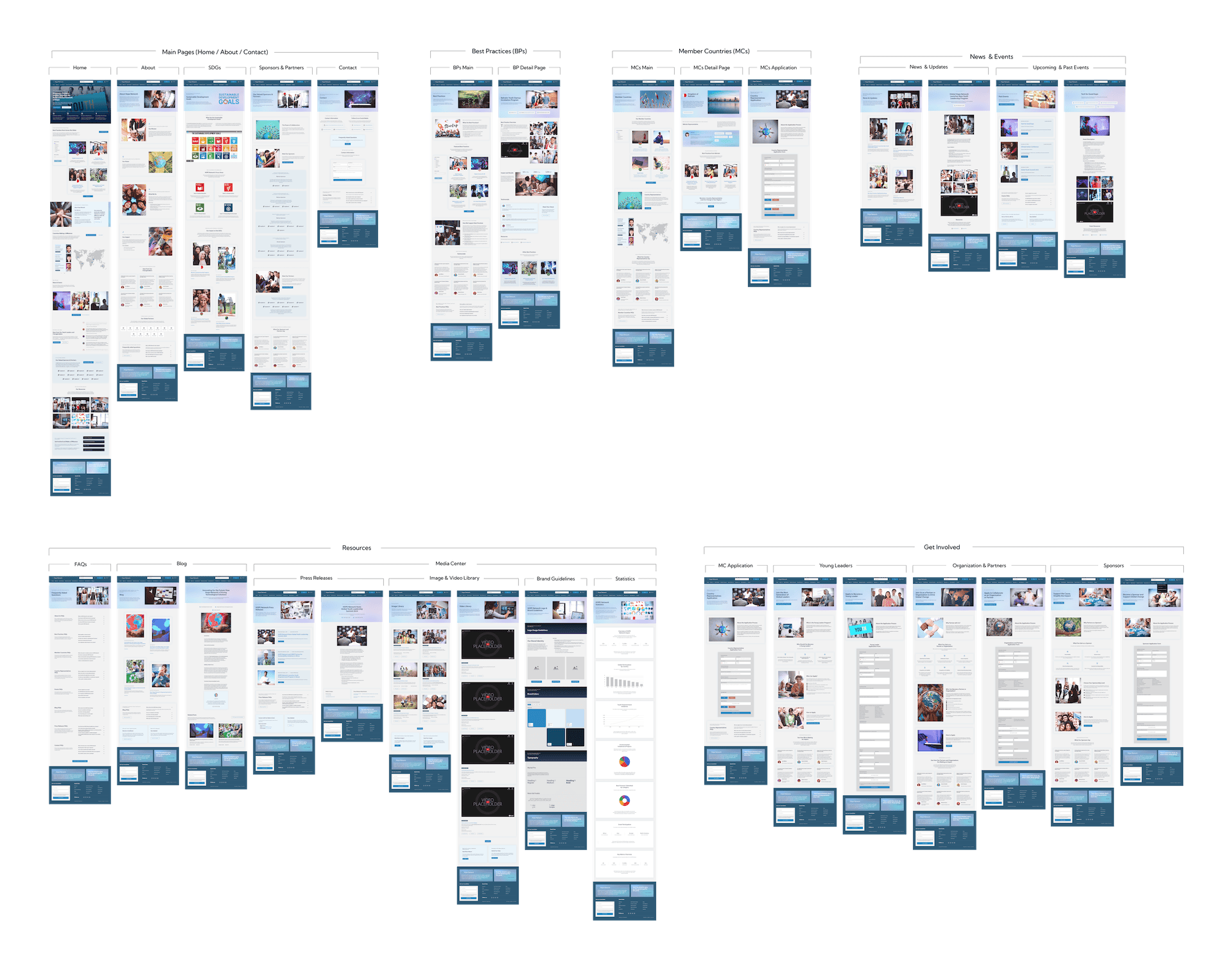
Client Collaboration:
- The client provided feedback on the visual hierarchy and branding elements, ensuring that the design aligned with their vision of youth empowerment and global collaboration.
- We incorporated the client’s input on color schemes, making adjustments to better highlight important sections like the Best Practices and Member Countries.
- Specific design enhancements included refining the interactive elements, such as the global map and the statistics page, to align with the brand’s mission of accessibility and clarity.
By integrating these enhancements and feedback, we developed a cohesive visual experience that resonates with the HOPE Network’s objectives.
Front-End Development:
Front-end development was partially done during the wireframing phase using ACSS, ensuring that development was streamlined and efficient. We utilized ACSS and Frames for quick development while maintaining flexibility and scalability.
- Custom Post Types (CPTs): We built dynamic CPTs for Best Practices, Member Countries, Events, and Press Releases to manage content seamlessly across the platform.
- Responsive & Interactive Features: We ensured the site was fully responsive, with automatic scaling for mobile and tablet views. Interactive features, like filtering options in the Best Practices Library and the interactive global map on the Member Countries page, were implemented to enhance user engagement.
- SEO & Performance Optimization: We used tools like Rank Math to set up SEO optimization, ensuring that the site is discoverable and ranks well on search engines. Performance was also optimized using techniques such as image compression, lazy loading, and efficient coding practices.
This phase integrated both the design and development efforts to create a site that is visually engaging, functional, and user-friendly.
Write a des, pupuse of each of these pages (Home, About, SDGs, Sponsors & partners, Contact) This will be added to the case study.
6. Content Strategy & Integration
Content Development:
To structure the content effectively, we utilized CPTs, which allowed for dynamic, organized content management throughout the site. The content strategy focused on:
- Best Practices: We categorized Best Practices by SDGs and countries, making it easy for users to find relevant initiatives.
- Member Countries: Each country page was dynamically populated using data from the CPTs, showcasing their representatives and Best Practices.
- Resources Section: We organized FAQs, press releases, image and video libraries, and statistics into intuitive layouts to ensure users could quickly access the information they need.
Dummy Content Integration:
- During the development phase, we used dummy content for each CPT to demonstrate functionality and provide the client with a realistic preview of the site.
- This approach allowed the client to visualize how the platform would function once live content was added, facilitating smoother collaboration and feedback.
SEO and Performance Optimization:
- We employed Rank Math for SEO optimization, ensuring each page, post type, and media file was correctly tagged with keywords and meta descriptions.
- Performance Optimization: We used tools like GTMetrix to monitor site speed and performance. To maintain fast load times, we implemented lazy loading for images and videos, minified CSS/JS files, and compressed media files.
- We also integrated caching solutions and utilized a CDN for efficient content delivery globally, ensuring that users across different regions have a seamless experience.
These strategies ensured that the HOPE Network site was not only optimized for user engagement but also performed efficiently, delivering a fast, accessible, and search-friendly platform.
7. Visual Assets and Enhancements
In the Visual Assets and Enhancements process, we carefully selected images that aligned with the brand’s identity and the project’s theme. We began by curating a collection of high-quality images that matched our visual goals and unified the look and feel of the site. Each image was resized and optimized for performance, ensuring fast load times without compromising quality. To create consistency across the site, we applied a uniform filter, enhancing the visual harmony.
Images were organized into categories, making them easy to manage and access when building different sections of the site. For icons, rather than designing from scratch, we sourced premium icons from a stock image and icon library. This allowed us to choose from a wide variety of high-quality options while maintaining a consistent visual style throughout the project.

These visual assets help visitors connect with the network’s mission and provide an interactive way to explore the global impact of the initiatives.

These icons provide a visual cue for users, making navigation intuitive and reinforcing the message of each section.
Asset Grouping and Organization in the Backend
To maintain an efficient and structured workflow, all images and icons were systematically organized in the backend. We created dedicated folders for each asset type, such as hero images, icons, and section-specific visuals. Additionally, images were further grouped into categories based on their usage, such as ‘Homepage Banners,’ ‘Team Photos,’ and ‘Blog Thumbnails.’ This folder structure not only streamlined the development process but also allowed for quick access and updates, ensuring consistency and clarity across the project.
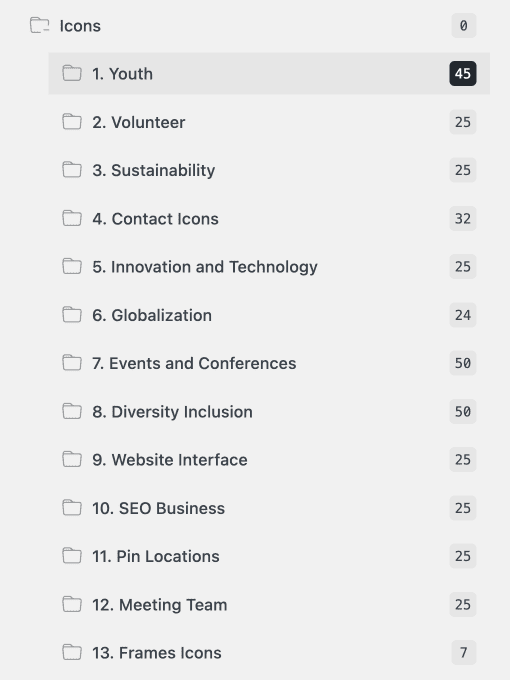
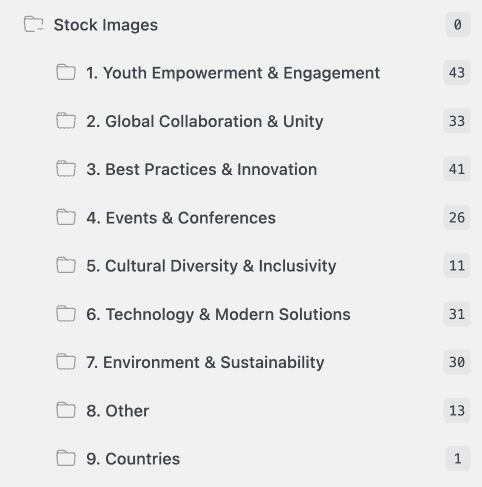
Infographics and Data Visualizations:
To present data in an engaging and informative manner, we implemented infographics and charts using the Chartify plugin for the Statistics page. The visualizations showcase data such as:
- Environmental Impact: Pie charts illustrating the percentage of tree planting and renewable energy projects.
- Best Practices Submitted: A breakdown of Best Practices categorized by SDGs and regions.
- Youth Participation Metrics: Bar graphs showing the number of youth leaders participating in various programs.
- Event Attendance: Line charts detailing the attendance growth over the past years.
Chartify allowed us to create interactive, mobile-optimized charts, ensuring that users can engage with the data on any device. The infographics provide clear, impactful visuals that illustrate the network’s progress and achievements.
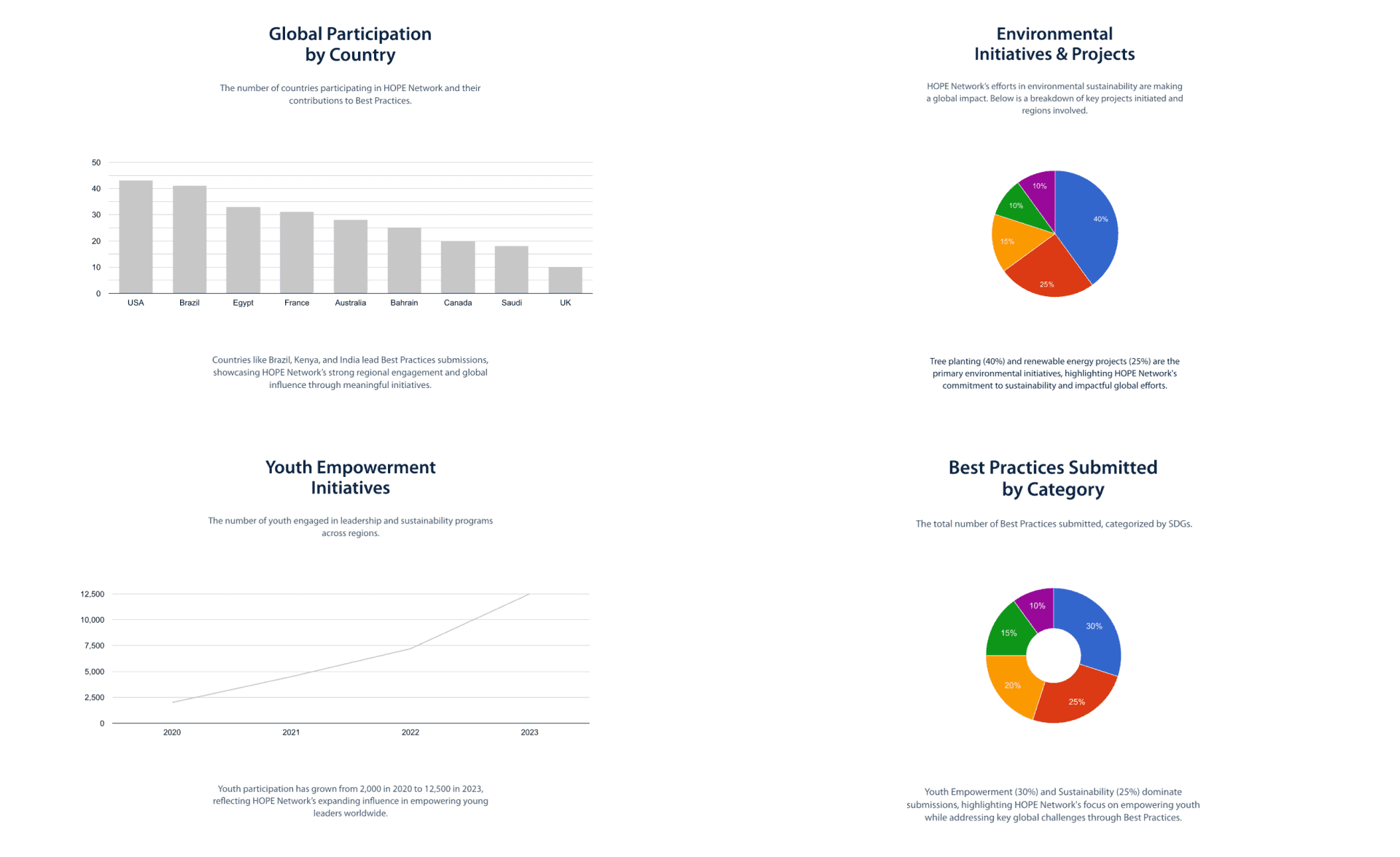
Consistency and Accessibility:
We applied filters and design elements to unify the visual assets, ensuring a cohesive look throughout the site. Background textures, such as subtle globe patterns and youth-focused illustrations, add depth and context to the site’s visual narrative.
- Accessibility: Each visual element was optimized for accessibility, ensuring that icons, images, and charts are screen-reader friendly and color-contrast compliant.
- Consistent Styling: All visual components were styled to match the site’s color palette and typography, creating a unified experience across all sections.
These enhancements not only enrich the user experience but also align with HOPE Network’s mission to create an inclusive, engaging platform.
8. Testing & Quality Assurance
Cross-Browser & Device Testing:
To ensure a seamless experience for all users, we conducted comprehensive testing across various browsers and devices. Our goal was to guarantee that the website’s design and functionality remained consistent and accessible, regardless of the platform.
- Browser Compatibility:
We tested the site on multiple browsers, including Chrome, Firefox, Safari, and Edge, to identify and resolve any discrepancies in appearance or functionality. - Device Responsiveness:
The site was tested across mobile devices, tablets, and desktop screens to confirm that all elements adjusted fluidly. Using ACSS’s built-in mobile optimization features, we ensured the design and interactive components performed smoothly across all screen sizes.
By conducting rigorous cross-browser and device testing, we were able to optimize the site’s performance and guarantee a consistent, high-quality user experience.
User Testing and Feedback:
Engaging with the target audience early in the development process was crucial for refining the website’s design and usability. We conducted user testing sessions with a group of youth leaders and representatives from the network to gather real-time feedback.
- User Navigation Tests:
Participants navigated through key areas of the site, such as the Best Practices Library and Member Countries sections, to assess the intuitiveness of the navigation flow and interactive features. - Content Accessibility:
We tested content readability and accessibility using screen readers and other assistive tools to confirm that the site met accessibility standards, ensuring that all users, including those with disabilities, could access information effectively.
Based on user feedback, we made several adjustments, such as simplifying the navigation menu, enhancing the visibility of CTAs, and ensuring that images and icons had appropriate alt text for accessibility.
Bug Fixing & Iteration:
As part of the testing process, we identified and resolved various bugs that could impact the user experience or performance of the website.
- Visual & Functional Bugs:
We conducted multiple rounds of testing to address visual issues, such as misaligned elements or inconsistencies in padding/margin. Functional bugs, such as broken links, interactive elements not responding correctly, and form submissions, were resolved to ensure a smooth experience. - Performance Optimization:
Using tools like GTMetrix, we monitored the website’s loading times and optimized elements, such as compressing images, implementing lazy loading, and reducing script load times. This resulted in improved page speeds and performance scores across devices.
Each round of testing was followed by a review session to validate that the fixes were successful and that new issues had not arisen. This iterative approach ensured the site was fully functional and ready for launch.
9. Launch & Post-Launch Support
Deployment:
The deployment phase marked the transition from development to a live, accessible platform. We prepared for the launch by conducting a final round of quality assurance tests to ensure the site’s stability and performance. The deployment process included:
- Final Checks:
A comprehensive review of all functionalities, including interactive features, responsiveness, and browser compatibility, to identify and fix any last-minute issues. - Staging Environment Deployment:
We first deployed the website to a staging environment, allowing the client to review the entire site in a live, yet private, setting. This enabled final feedback and gave the client the opportunity to request any minor changes before the public launch. - Public Launch:
Once approved, the site was officially launched using a coordinated release plan. We ensured a seamless transition from the staging environment to the live site, minimizing downtime and ensuring that all domains, SSL certificates, and redirects were properly configured.
Training & Documentation:
To empower the client with full control over their new platform, we provided comprehensive CMS training and documentation.
- CMS Training Sessions:
We conducted live training sessions with the HOPE Network team, demonstrating how to manage content, upload new Best Practices, update member country profiles, and utilize the media library. This hands-on approach ensured the client could confidently navigate the backend and make updates independently. - User Manuals & Guides:
We created detailed user manuals covering key aspects of the CMS, such as managing CPTs (Custom Post Types), updating FAQs, and optimizing SEO settings. The guides include step-by-step instructions, visuals, and troubleshooting tips for a smooth content management experience.
The training and documentation equipped the client with the knowledge and resources needed to manage their platform effectively and maintain its functionality over time.
Maintenance & Support:
We established a comprehensive post-launch support plan to ensure the site remains secure, updated, and optimized.
- Ongoing Maintenance:
We provided a maintenance package that includes regular software updates, security monitoring, and performance optimizations to keep the site running smoothly and securely. - SEO Monitoring:
We continue to track the site’s SEO performance using Rank Math, making adjustments as needed to enhance visibility and search rankings. This includes monitoring keywords, optimizing content, and analyzing traffic patterns to ensure the site reaches its target audience effectively. - Feature Enhancements:
The post-launch support also covers the addition of new features or adjustments based on evolving client needs. We offer periodic consultations to explore opportunities for expanding the site’s capabilities, ensuring that the platform grows alongside HOPE Network’s mission and audience.
This comprehensive approach to launch and post-launch support ensures that HOPE Network’s platform remains secure, scalable, and optimized for future growth.
10. Future Enhancements
Phase Two Development:
As HOPE Network continues to grow, we have planned a second phase of development to further enhance the platform’s capabilities and expand its reach.
- Affiliate Marketing Links:
To increase partnerships and collaborations, we will incorporate an affiliate marketing system that allows strategic partners and sponsors to promote HOPE Network initiatives, expanding its visibility and reach. - Membership Portal:
We intend to develop a backend portal specifically for industry participants. This portal will provide an interface for data entry and tracking, allowing participants to monitor their contributions and updates to the Plastic Monitor.
By expanding the site’s capabilities, we aim to create a self-sustaining and interactive platform that continues to serve HOPE Network’s mission as it evolves.
Partnership Expansion:
The site will be designed to adapt as new countries, organizations, and strategic partners join the network. Future iterations of the platform will focus on expanding the Member Countries and Partners sections to reflect new partnerships and growth.
- Interactive Maps Update:
We will expand the interactive map to include new member countries and partners, highlighting their contributions and initiatives. - Automated Country & Partner Profiles:
Profiles for new countries and partners will be automatically generated as they join, providing dynamic updates on their activities, events, and best practices.
This flexibility ensures that the platform continues to scale with HOPE Network’s expanding reach and impact.
11. Visuals & Screenshots
Annotated Screenshots:
To visually illustrate the journey of the HOPE Network website, we will include annotated screenshots for each key page:
1. Home
Description: The homepage serves as the primary gateway to the website, offering a comprehensive overview of the platform’s mission, services, and key highlights. It provides a user-friendly navigation system and introduces visitors to the most important sections, including ‘Get Involved,’ ‘Resources,’ ‘News & Events,’ and other relevant pages.
Purpose: To engage visitors immediately and provide them with a clear understanding of the organization’s objectives and offerings. It acts as a central hub, directing users to various areas of interest and ensuring easy access to essential information and calls to action.
2. About
Description: This page provides an in-depth explanation of the organization’s mission, vision, values, and history. It includes information about the organization’s team, milestones, and the impact it has made.
Purpose: To establish credibility and build trust with the audience by showcasing the organization’s story, goals, and achievements. It also serves as a platform for visitors to learn more about the people behind the initiative and the overarching objectives that drive the organization’s efforts.
3. Sustainable Development Goals (SDGs)
Description: The SDGs page explains how the organization aligns its mission with the United Nations Sustainable Development Goals. It highlights specific goals the organization focuses on and illustrates the impact of their initiatives within these global frameworks.
Purpose: To demonstrate the organization’s commitment to global standards and its role in supporting sustainable development. This page educates visitors on the relevance of the SDGs and connects the organization’s work with a larger, internationally recognized framework, fostering credibility and broader support.
4. Sponsors & Partners
Description: This page showcases the organization’s sponsors and partners, acknowledging their contributions and partnerships. It provides details about sponsorship levels and partnership opportunities, inviting other organizations and individuals to join and support the cause.
Purpose: To recognize and highlight existing partnerships while creating opportunities for new sponsors and partners. This page also serves as a call to action for potential collaborators, offering information on how they can engage with and support the organization’s mission.
5. Contact
Description: The Contact page provides various ways for visitors to get in touch with the organization. It includes a contact form, office location details (if applicable), and relevant email addresses or phone numbers for direct communication.
Purpose: To offer an accessible and straightforward way for visitors, potential collaborators, and partners to reach out with inquiries or support requests. This page ensures that communication lines are open, facilitating engagement and interaction with the organization.
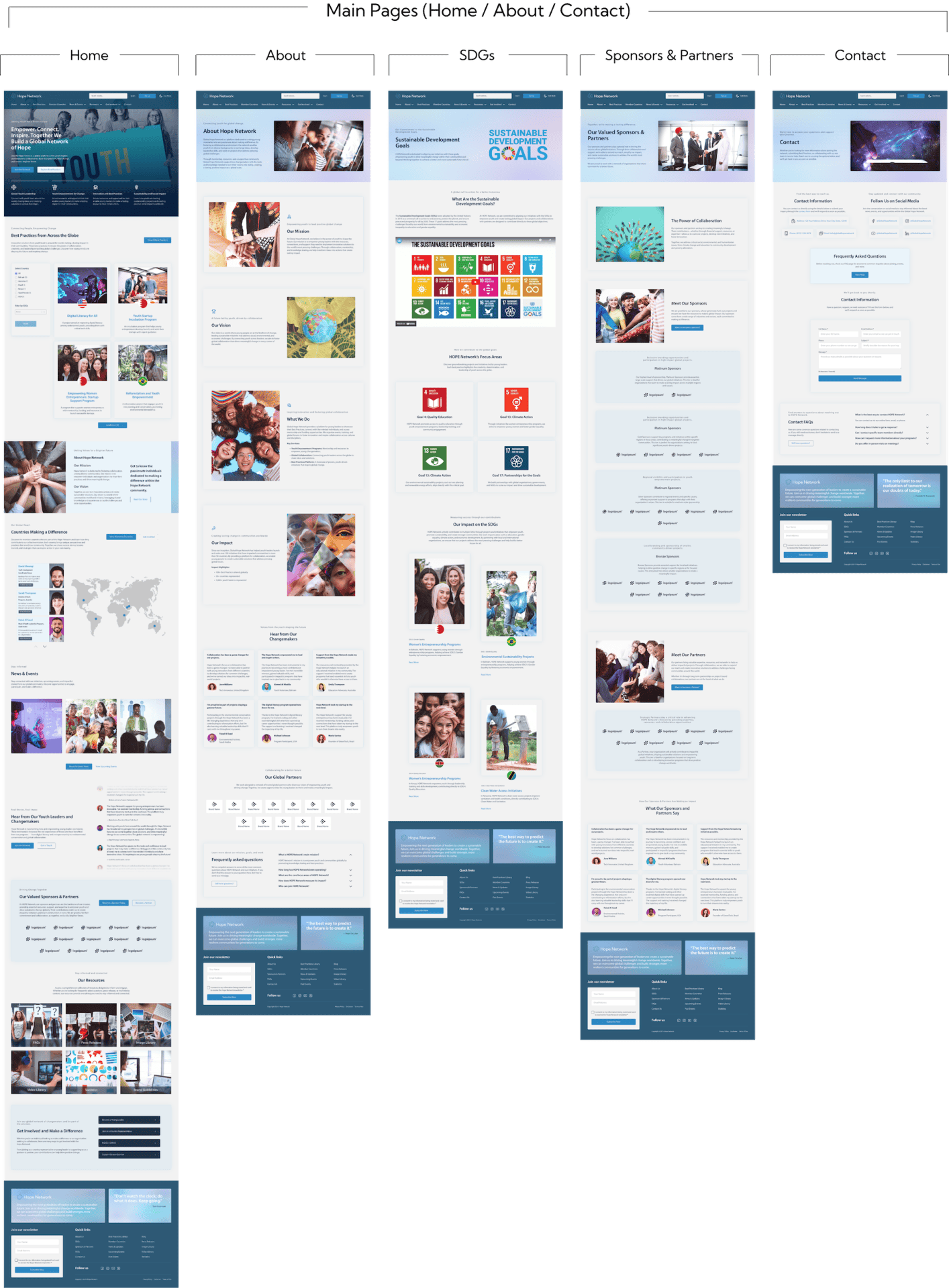
6. Best Practices (Main Page)
Description: The Best Practices main page serves as a comprehensive library, showcasing a collection of successful strategies and initiatives implemented by members of the network. It features a grid or list view with filters by category, country, and region, allowing users to explore diverse best practices based on their interests.
Purpose: To provide a centralized resource hub where users can access, explore, and learn from effective initiatives implemented by network members. This page aims to inspire and guide other organizations and individuals in replicating or adapting these practices in their own contexts, fostering knowledge sharing and collaboration.
7. Best Practices (Detail Page)
Description: The Best Practices detail page provides an in-depth look at a specific initiative. It includes a summary of the practice, its objectives, steps taken, results achieved, and any resources or materials used. The page also highlights the organization or individual behind the initiative and offers downloadable content or links for further information.
Purpose: To present detailed insights into each best practice, allowing visitors to understand its impact and implementation process fully. The page serves as an educational tool, offering practical information and resources that users can adapt to their own projects. It also acknowledges and credits the efforts of the individuals or organizations behind the initiatives, encouraging others to contribute their own best practices.
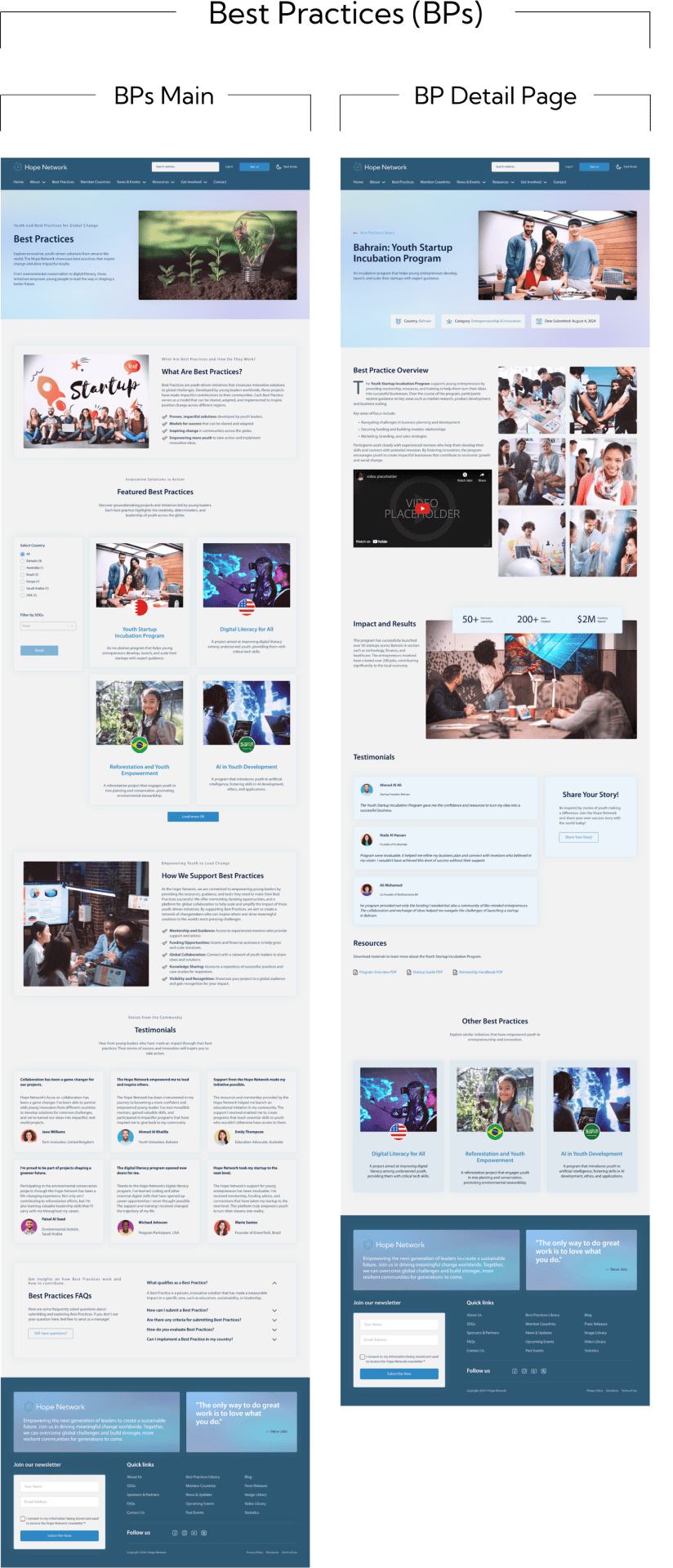
8. Member Countries (Main Page)
Description: The Member Countries main page displays an overview of all countries participating in the network. It features a grid or map view that organizes countries by region or continent, with filters for easy navigation. Each country profile can be accessed directly from this page, providing users with a quick snapshot of the network’s global reach.
Purpose: To offer visitors a visual and interactive representation of the network’s member countries, emphasizing the international scope of the organization’s efforts. This page serves as a gateway to explore specific country profiles and encourages users to understand the network’s diversity and impact.
9. Member Countries (Detail Page)
Description: The Member Countries detail page provides comprehensive information about a specific country’s involvement in the network. It includes the country’s profile, initiatives, best practices contributed, and impact statistics. The page may also showcase the country’s representatives, and success stories, and provide downloadable resources related to their initiatives.
Purpose: To offer a deeper insight into each member country’s contributions and achievements within the network. This page serves as a resource for learning about the specific initiatives and strategies implemented by that country, fostering collaboration and knowledge sharing among users interested in similar efforts.
10. Member Countries (Application Page)
Description: The Member Countries application page is an online form for countries interested in joining the network. It includes sections to provide information about the country’s objectives, key contacts, and previous or ongoing initiatives. The page guides applicants through the process, explaining the criteria for membership and the benefits of joining.
Purpose: To facilitate the application process for countries wishing to become members of the network. This page ensures a smooth and informative onboarding experience, encouraging eligible countries to participate and contribute to the organization’s mission. It serves as a critical point of engagement, expanding the network’s global reach and diversity.
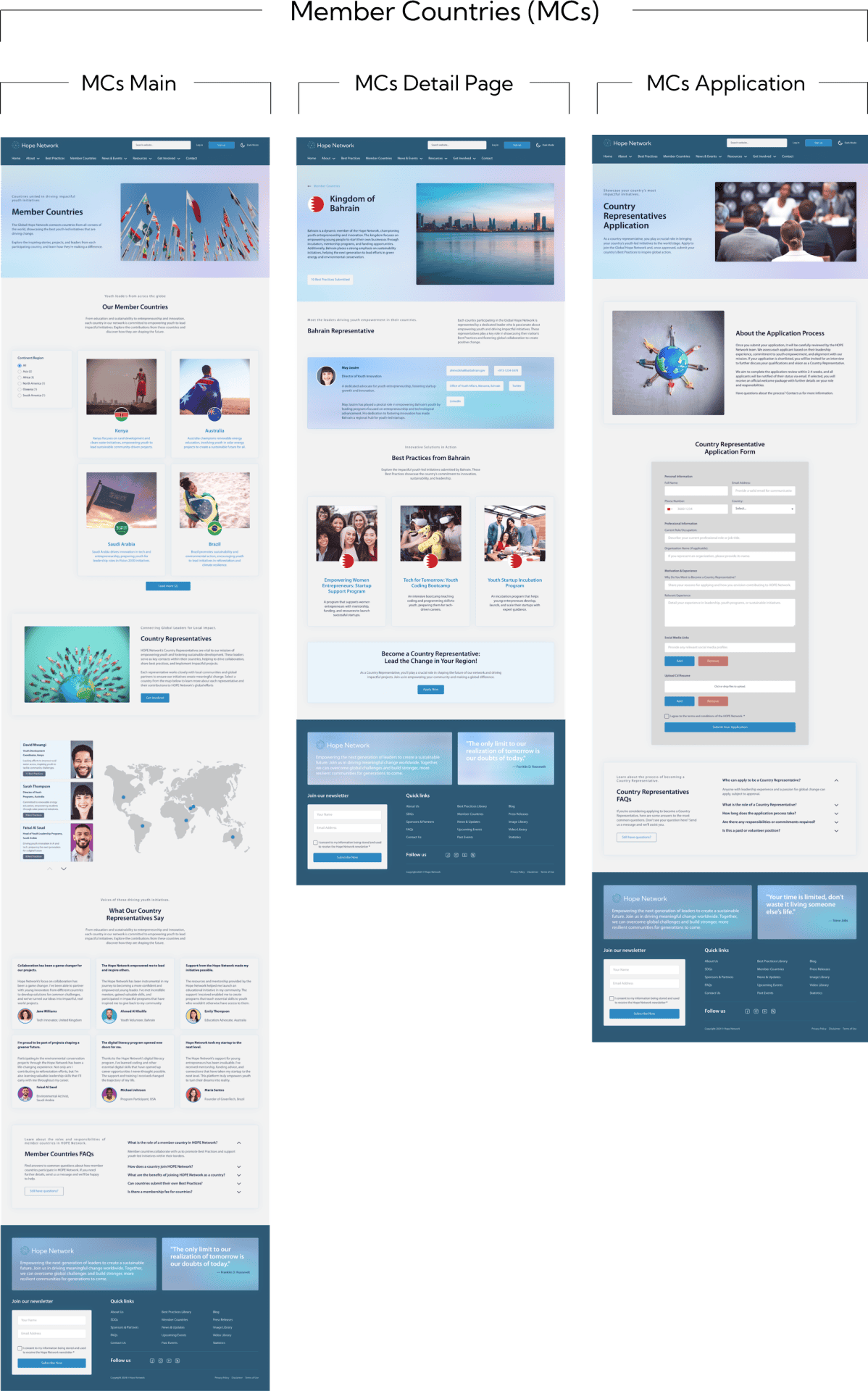
11. News and Update
Description: The News and Update page provides the latest information about the organization’s activities, announcements, achievements, and relevant industry news. It features a blog-like layout with articles, updates, and press releases organized chronologically or by category.
Purpose: To keep visitors informed about the organization’s latest developments and industry-related news. This page serves as a dynamic and regularly updated source of information, enhancing engagement and ensuring that the audience stays connected with the organization’s ongoing efforts and milestones.
12. Upcoming Events
Description: The Upcoming Events page showcases a calendar or list view of all scheduled events, such as workshops, conferences, webinars, and community engagements. Each event includes details such as date, time, location (if applicable), registration links, and a brief description of the event’s objectives and agenda.
Purpose: To inform visitors about upcoming opportunities for engagement and participation. This page acts as a central hub for event promotion, encouraging visitors to register and join the organization’s activities, fostering community involvement and expanding the network’s reach.
13. Past Events
Description: The Past Events page features a catalog of previously held events, providing summaries, outcomes, and multimedia content such as photos, videos, and presentation slides. It is organized by date and category, making it easy for visitors to explore the history of events the organization has hosted or participated in.
Purpose: To offer visitors a record of the organization’s past events, highlighting their impact and success. This page serves as a resource for those who want to revisit event materials or learn from previous sessions, demonstrating the organization’s ongoing commitment to engagement and knowledge sharing.
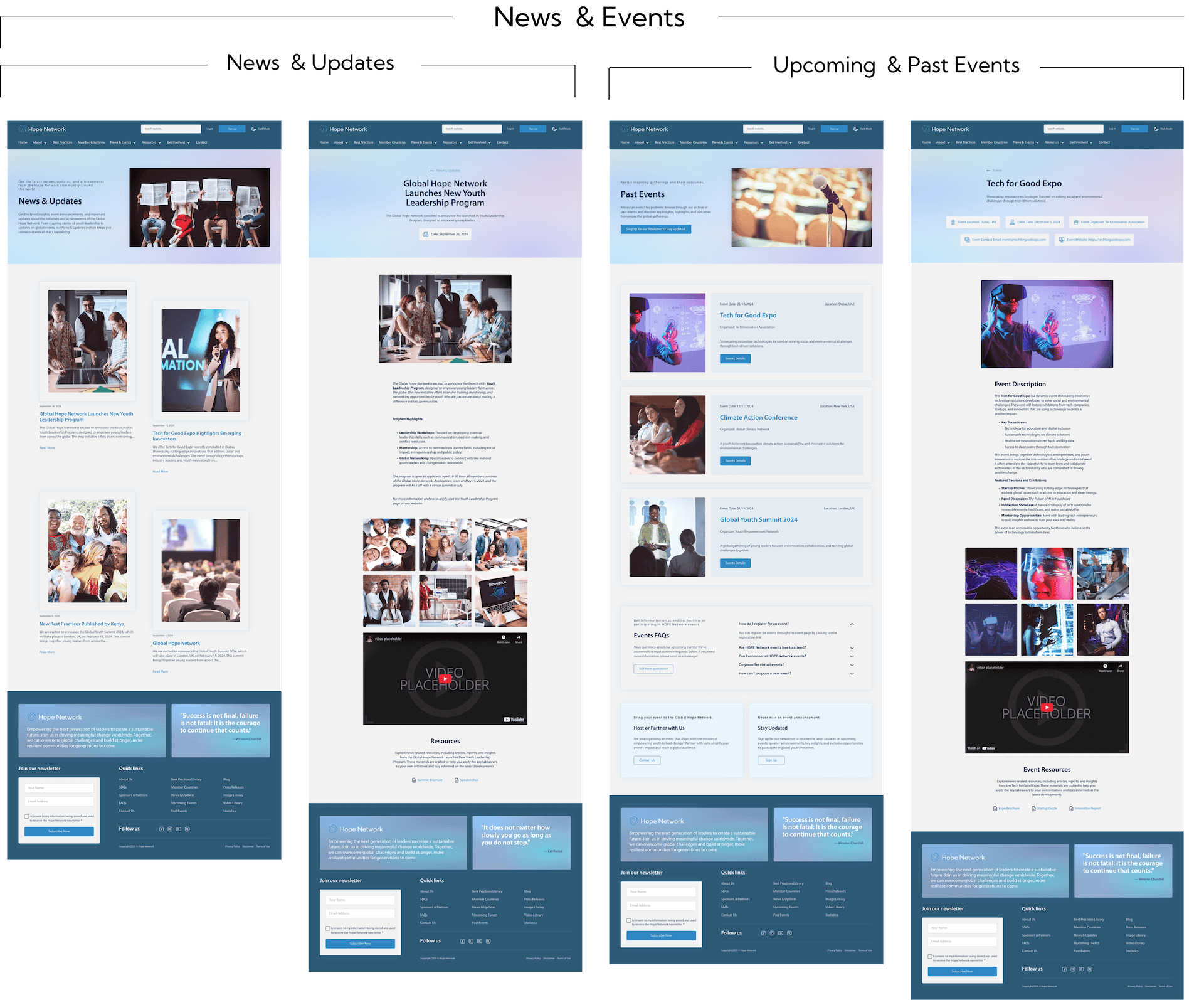
The Resources dropdown is designed to provide valuable information and tools to support and empower our community. Here, you’ll find a wide range of materials, including FAQs, press releases, image and video libraries, and detailed statistics. These resources are crafted to help you stay informed, share knowledge, and access the latest updates and data. Explore the collection and make the most of the insights and information available.
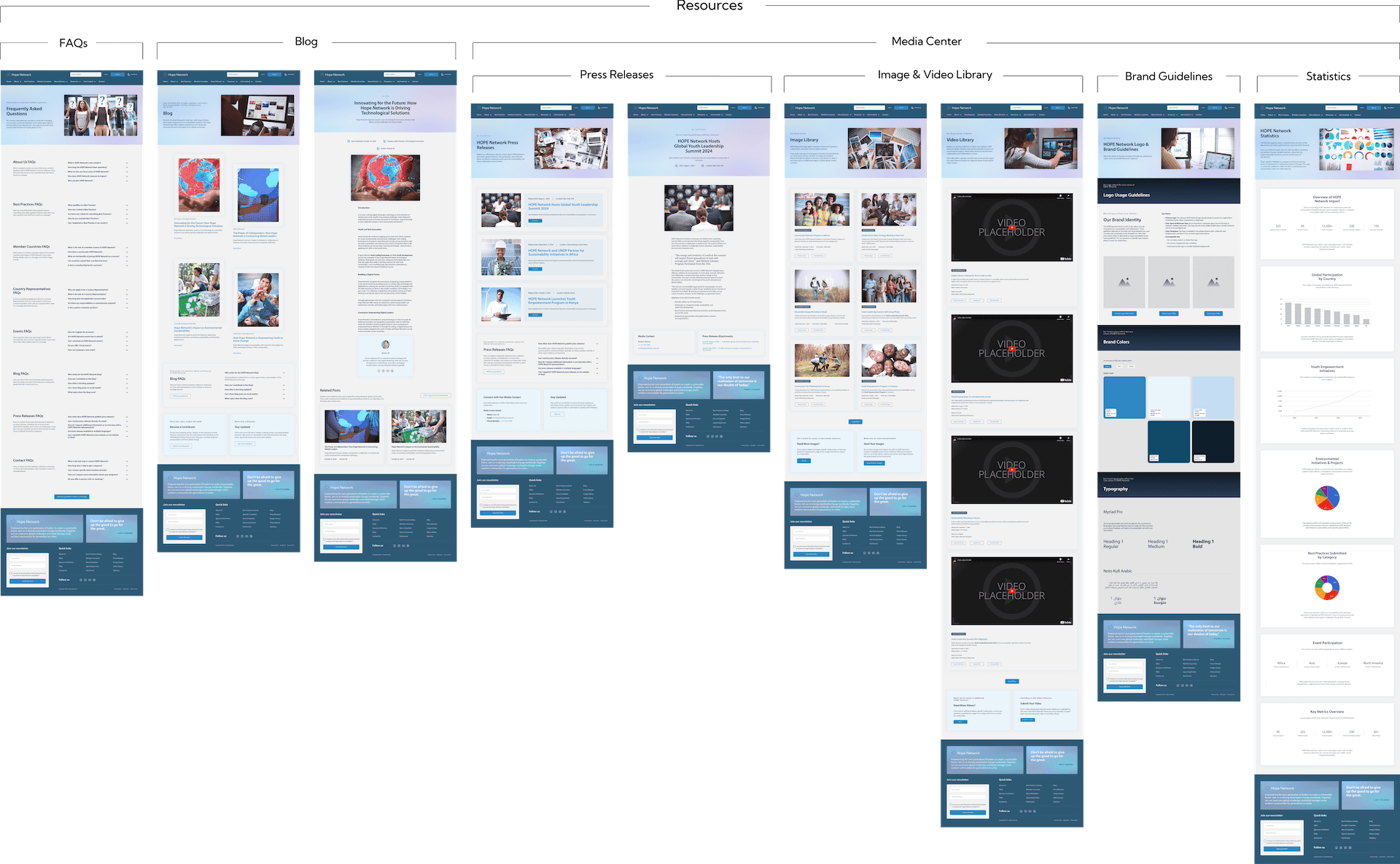
14. FAQs
Description: The FAQs (Frequently Asked Questions) page provides a collection of common questions and their answers related to the organization, its mission, services, and processes. It is organized into categories for easy navigation, ensuring that visitors can quickly find the information they need.
Purpose: To offer a convenient and efficient way for visitors to access answers to common queries, reducing the need for direct support and improving user experience. This page serves as a self-help resource, empowering users to gain clarity on various topics and understand the organization’s offerings and operations.
15. Blog
Description: The Blog page features a series of articles, insights, and thought leadership content related to the organization’s mission, industry, and current events. Posts are organized by categories and tags, allowing users to explore topics that interest them. The page may also include guest posts or contributions from industry experts.
Purpose: To engage and educate the audience by providing valuable content that aligns with the organization’s goals and interests. The blog serves as a platform for sharing knowledge, best practices, and success stories, while also enhancing the organization’s SEO efforts and online visibility. It encourages interaction and community building through comments and social sharing options.
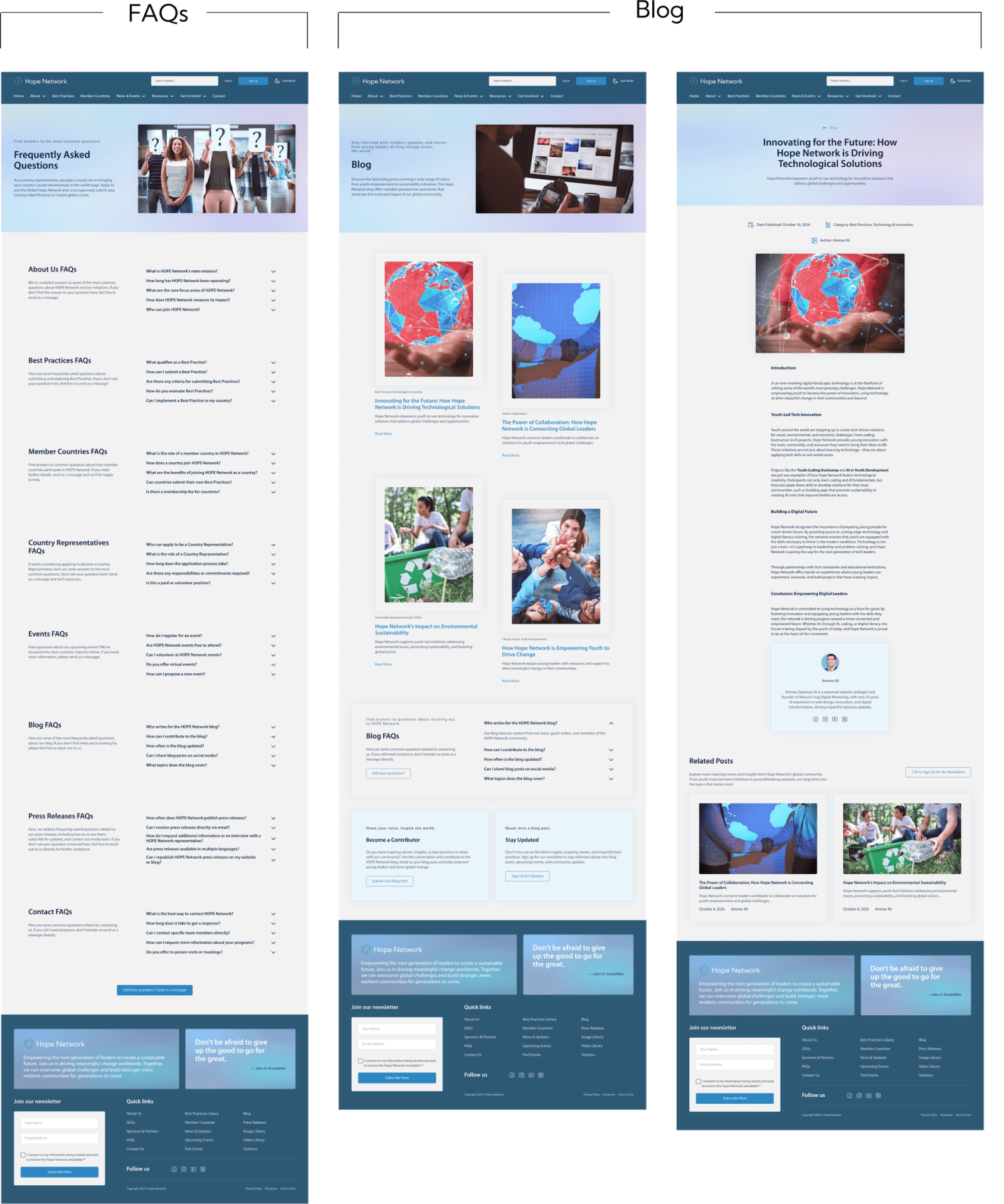
16. Press Releases
Description: The Press Releases page compiles official announcements and updates from the organization, including new initiatives, partnerships, achievements, and other significant developments. Each press release includes the date, a headline, and a detailed account of the announcement, often accompanied by images or videos.
Purpose: To provide an authoritative source of news directly from the organization, ensuring that stakeholders, media, and the public have access to accurate and up-to-date information. This page serves as a valuable resource for building transparency, credibility, and trust while enhancing the organization’s media presence and visibility.
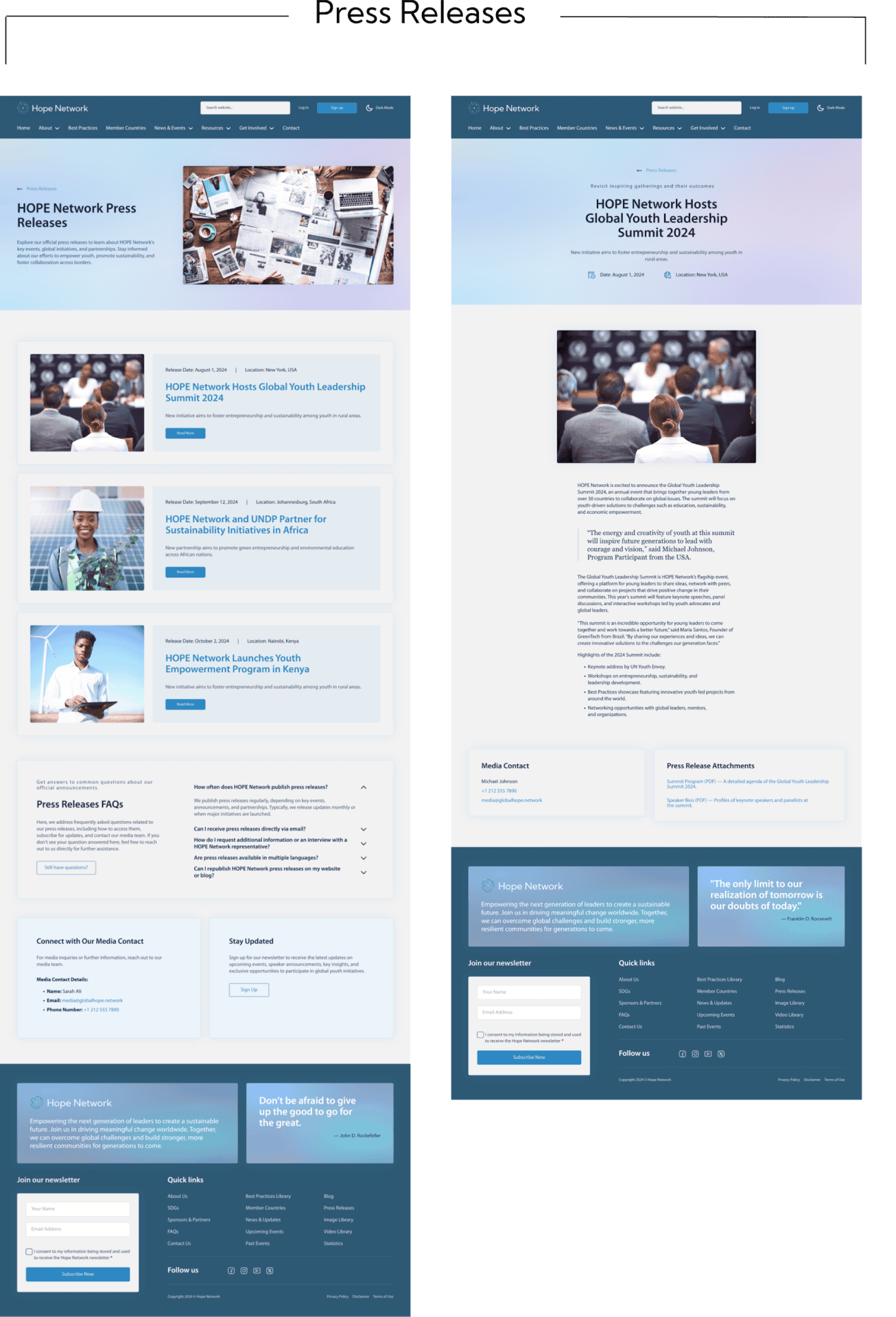
17. Image Library
Description: The Image Library page is a curated collection of images related to the organization’s activities, events, campaigns, and impact stories. The images are organized into categories or albums for easy browsing, and users can download them or share them on social media.
Purpose: To provide a visual representation of the organization’s work and achievements, enhancing storytelling and engagement. This page serves as a resource for the media, partners, and the public to access official images, ensuring consistency in the organization’s visual identity and messaging.
18. Video Library
Description: The Video Library page features a compilation of videos, including event highlights, interviews, tutorials, project showcases, and educational content. Videos are organized by category or playlist, allowing users to quickly find and view relevant content.
Purpose: To offer an engaging and interactive way for visitors to learn about the organization’s mission, activities, and impact. This page serves as a multimedia hub that enhances storytelling, increases user engagement, and provides a dynamic way for the audience to connect with the organization’s message. It also supports content distribution, as videos can be shared on social media and other platforms.
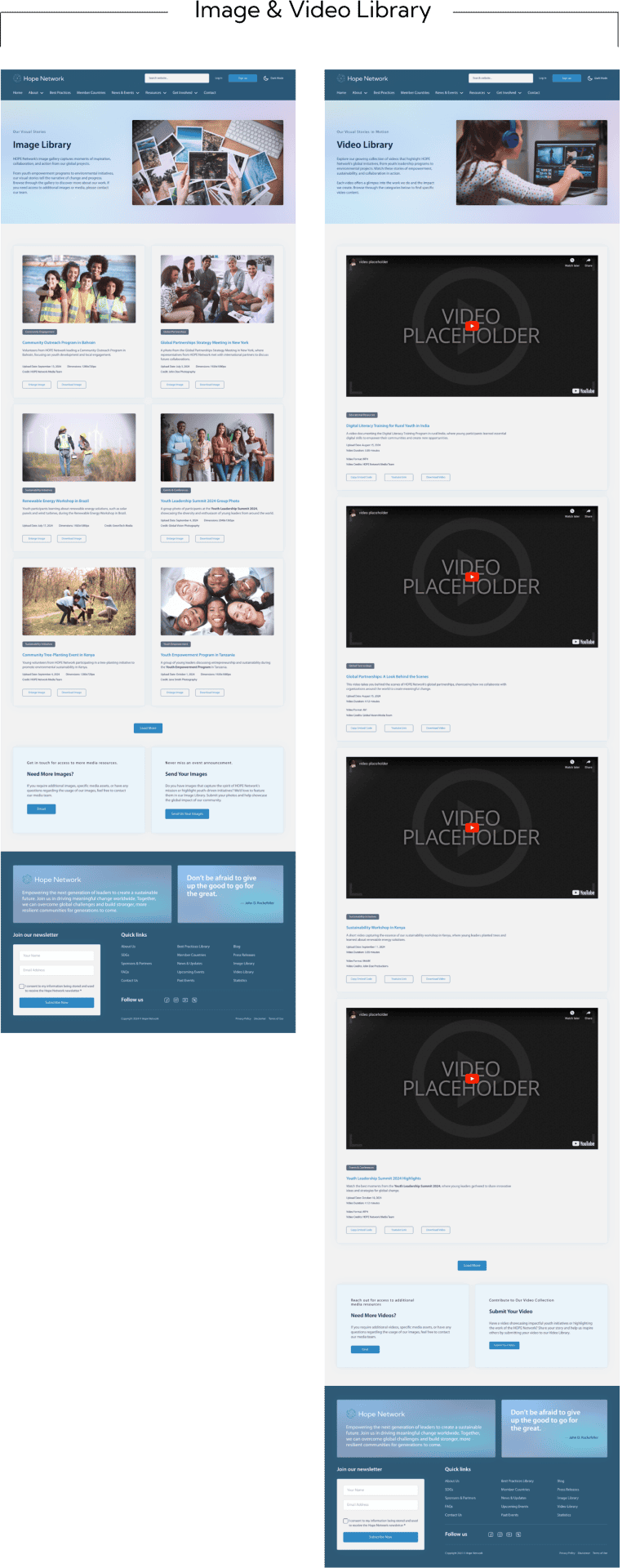
19. Brand Guidelines
Description: The Brand Guidelines page provides comprehensive details about the organization’s visual identity, including logo usage, color palette, typography, and design elements. It includes downloadable assets like logos and templates, along with instructions on how to maintain brand consistency across various platforms and materials.
Purpose: To ensure that partners, collaborators, and internal teams maintain a consistent and professional brand image when representing the organization. This page serves as a central resource for accessing brand assets and guidelines, supporting cohesive branding and effective communication across all media.
20. Statistics
Description: The Statistics page presents data and insights related to the organization’s impact and achievements. It features charts, graphs, and other visual tools that display metrics such as the number of initiatives completed, network growth, sustainability outcomes, and engagement levels. The page may also offer filters for users to view specific types of statistics or reports.
Purpose: To provide transparent and accessible information on the organization’s performance and impact. This page serves as an analytical resource for stakeholders, partners, and the public, showcasing the effectiveness of the organization’s efforts. It reinforces credibility and accountability by sharing measurable results and progress aligned with the organization’s goals.
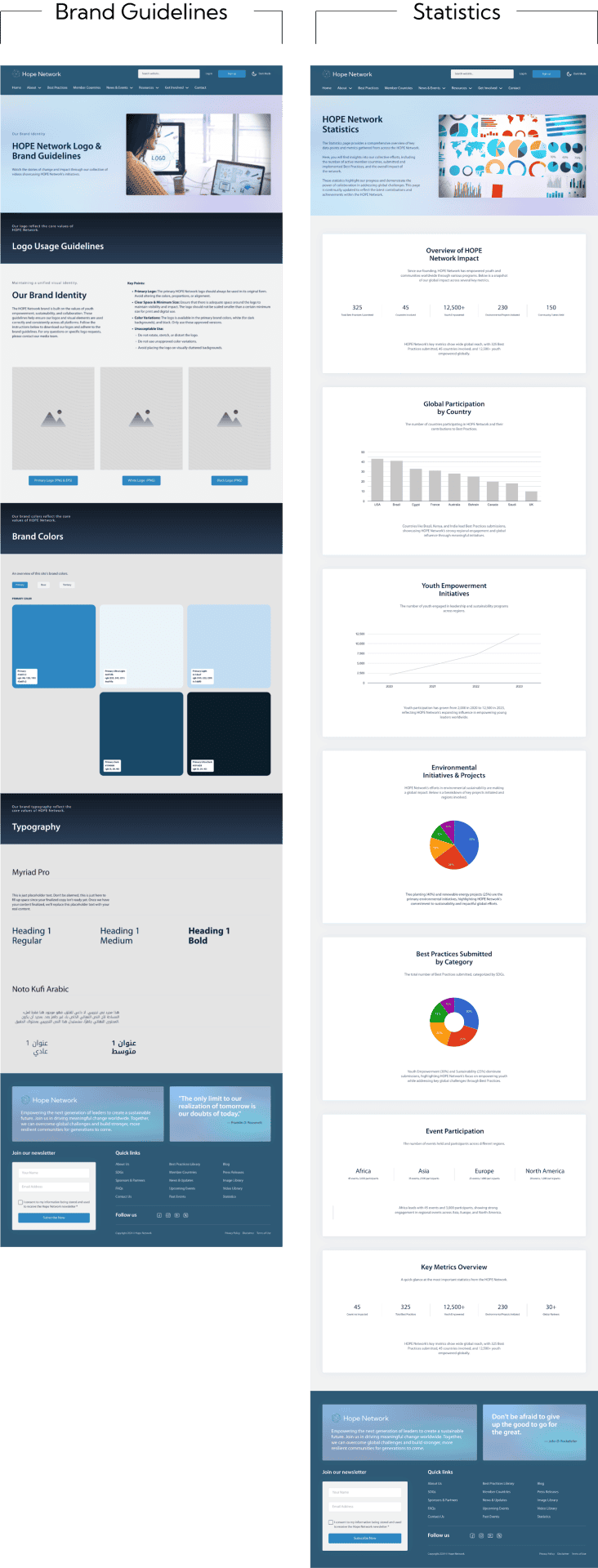
The Get Involved section offers various ways for individuals, organizations, and partners to actively participate in the network’s mission. Whether you’re a young leader eager to make an impact, an organization looking to collaborate, or a sponsor ready to support transformative initiatives, this is your opportunity to join a global community committed to making a difference. Explore the options available and take the next step in contributing to meaningful change.
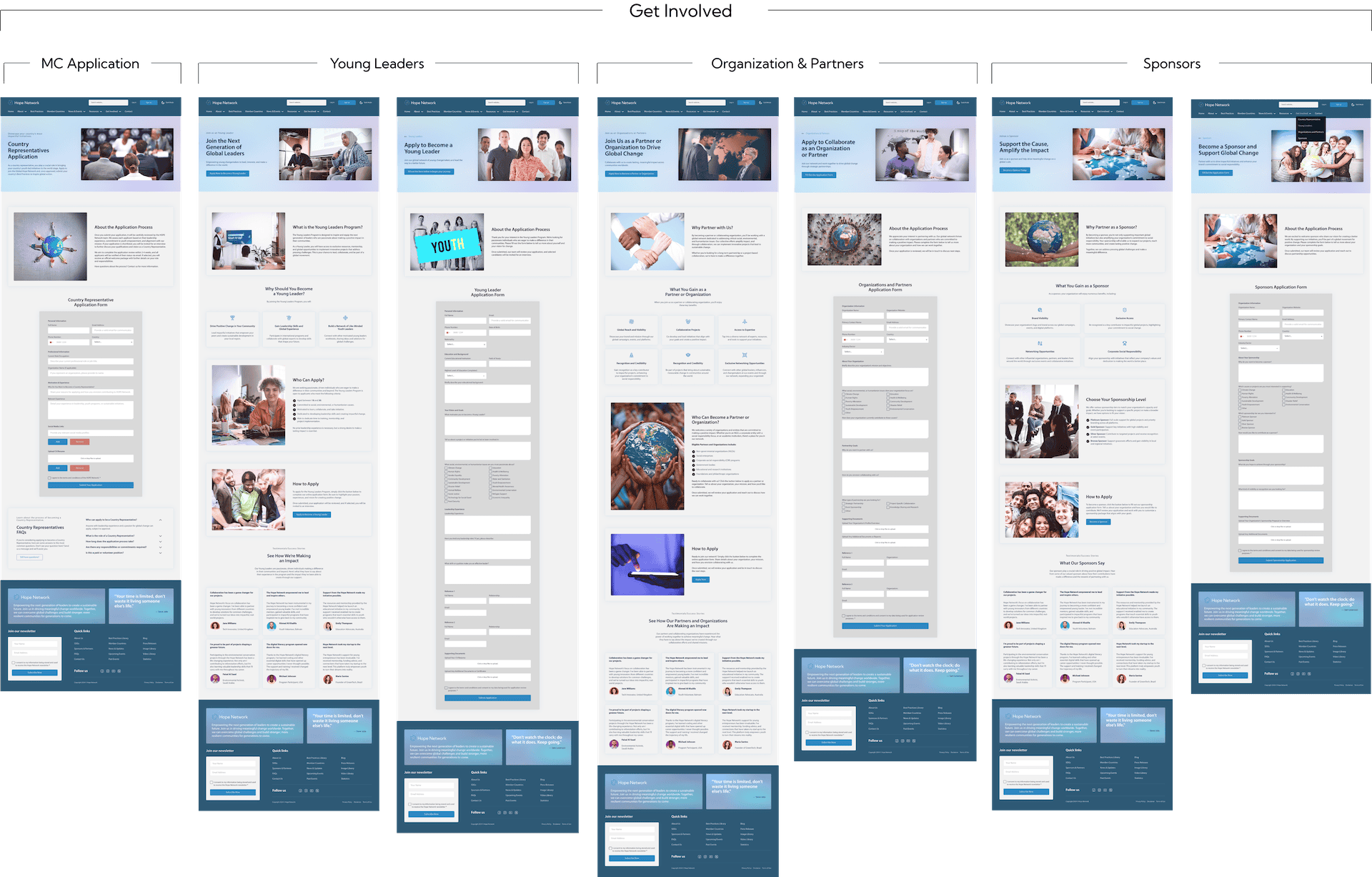
1. Member Country Application
Description: The Member Country Application page explains the program for countries interested in joining the network. It outlines the objectives of the program, eligibility criteria, benefits for participating countries, and the application process. The page includes testimonials from current member countries and a link to the application form.
Purpose: To inform prospective countries about the opportunity to join the network, providing clear details on how the program supports sustainable development and collaboration. This page encourages participation by highlighting the benefits of membership and offering a straightforward application process, expanding the network’s reach and impact.

2. Young Leader Page and Application
Description: The Young Leader page introduces the program designed for youth to become leaders and advocates within the network. It explains the program’s goals, eligibility criteria, and the role of young leaders in driving change. The page provides guidance on how to apply, including a link to the application form, and features testimonials from current or past young leaders sharing their experiences.
Purpose: To engage and attract young individuals passionate about making a difference, offering them a pathway to contribute to the organization’s mission. This page serves as an informative and motivational platform, encouraging youth involvement and providing the necessary information to apply and become part of the program.
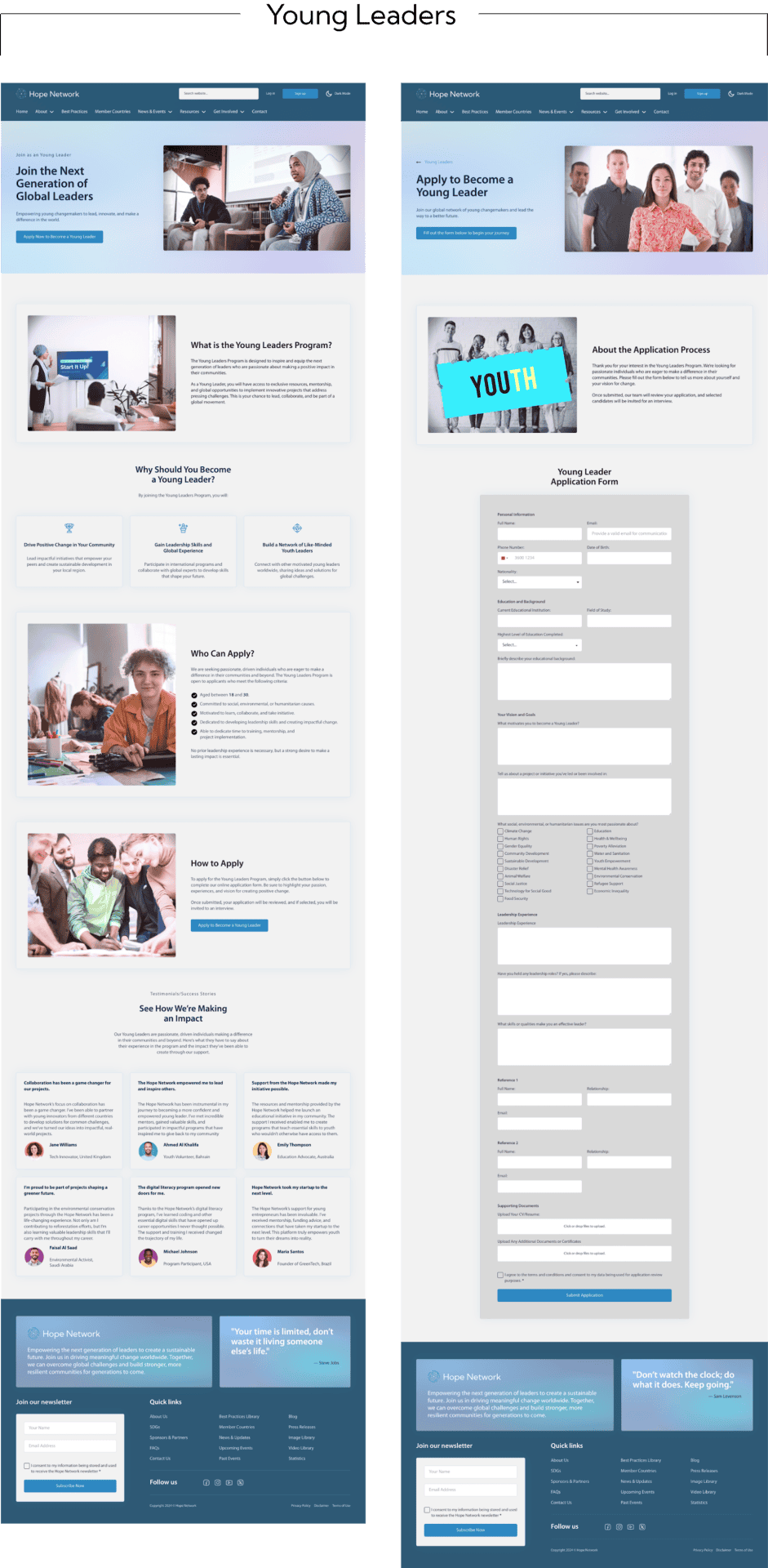
3. Organization & Partner Page and Application
Description: This page details the program for organizations and partners interested in collaborating with the network. It outlines the benefits of partnership, the types of support and collaboration opportunities available, and eligibility requirements. The page includes testimonials from current partners and organizations, as well as a link to the application form for those interested in joining.
Purpose: To attract strategic partners and organizations that align with the network’s mission, offering them an opportunity to contribute and collaborate on projects. This page serves as a comprehensive guide, explaining the value of partnership and providing the necessary steps to become involved, enhancing the organization’s resources and reach.
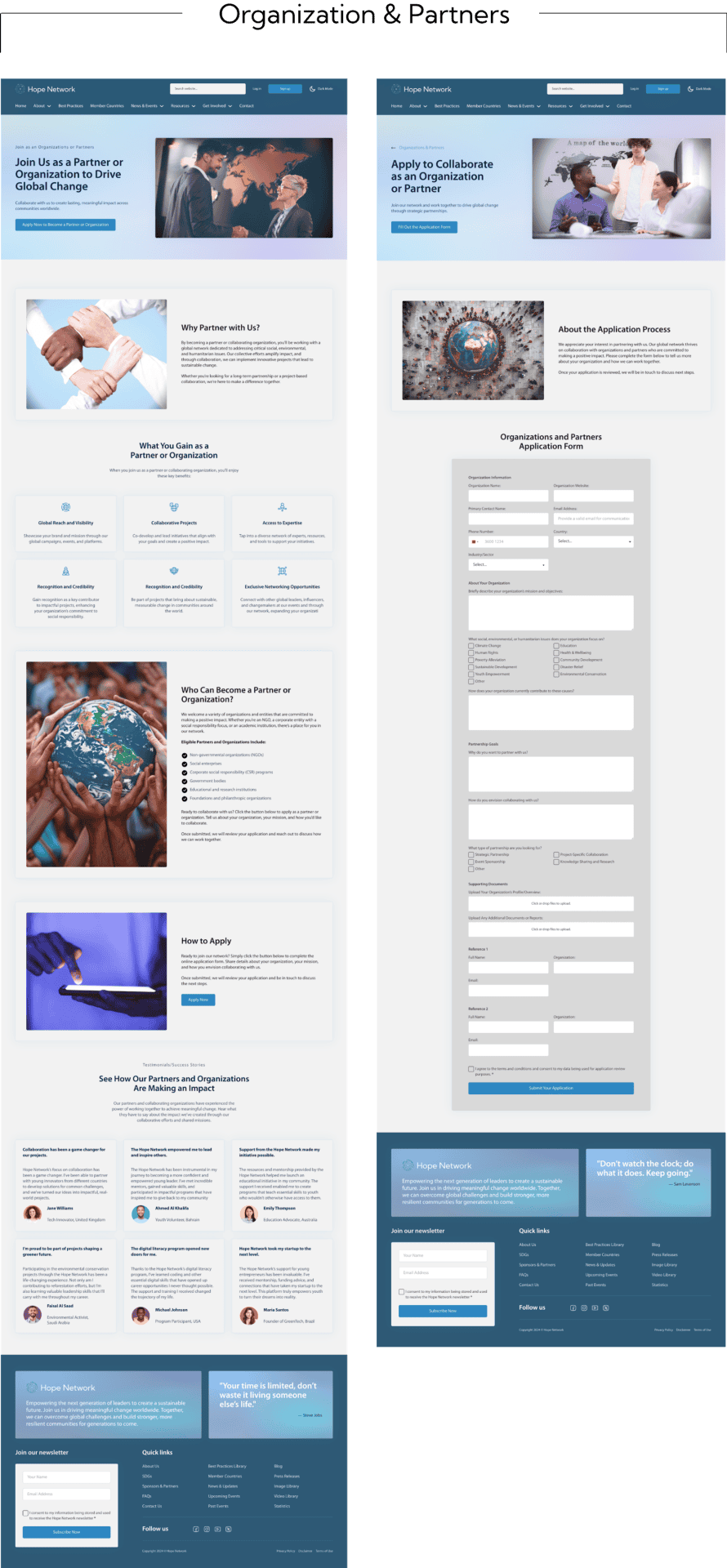
4. Sponsors and Application
Description: The Sponsors page provides information about the sponsorship program, explaining its importance, the impact of sponsorship contributions, and the different sponsorship levels available. It includes testimonials from existing sponsors highlighting the benefits of their involvement. The page guides prospective sponsors through the application process, linking directly to the sponsorship form for easy access.
Purpose: To encourage organizations and individuals to become sponsors by highlighting the positive impact of their support and showcasing testimonials from current sponsors. This page serves as an invitation for new sponsors to contribute, offering them a clear understanding of sponsorship opportunities and benefits, and ensuring a seamless application process.
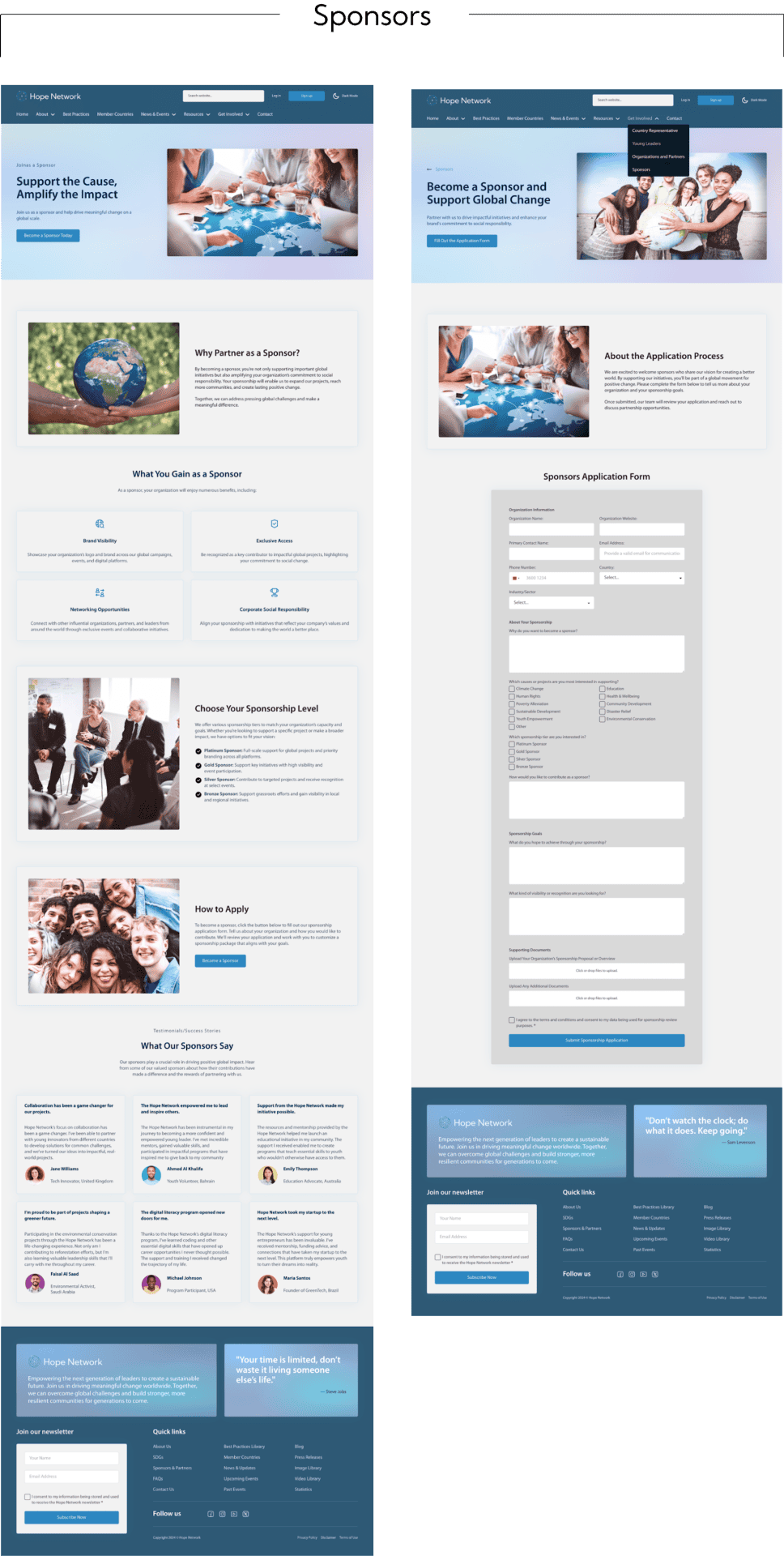
12. Case Study Wrap-Up
Results & Impact:
The HOPE Network website has successfully launched, creating a vibrant platform for youth engagement and collaboration on a global scale. Since launch:
- Website Traffic:
The site has seen a 150% increase in visitor traffic within the first three months, demonstrating its reach and engagement potential. - Best Practices Submissions:
Over 200 Best Practices have been submitted, with participation from 30+ countries, showing the platform’s effectiveness in mobilizing youth initiatives. - New Partnerships:
The network has attracted 15 new strategic partners and sponsors, reflecting its growing influence and appeal.
These results underscore the impact of the project, aligning with HOPE Network’s mission to empower youth and promote sustainable development globally.
Client Testimonial:
“We are thrilled with the outcome of the HOPE Network website. The collaborative process, attention to detail, and commitment to our vision have exceeded our expectations. This platform will be instrumental in driving our global initiatives and empowering young leaders worldwide.” — [Client Representative Name]
Final Thoughts:
This project showcased the importance of collaboration, flexibility, and client engagement. By working closely with the HOPE Network team, we created a scalable, accessible, and impactful platform that serves a global audience. Despite challenges such as tight deadlines and the need for extensive accessibility features, the project’s success demonstrates the power of aligning development strategies with a clear mission and vision.

